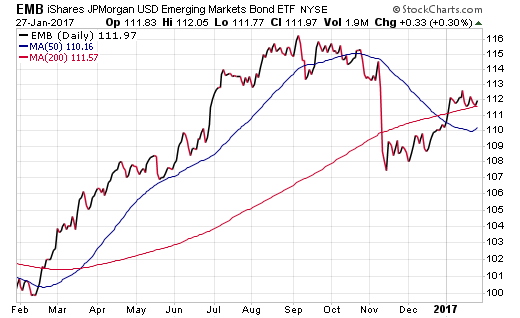Emerging market bonds were one of the few bright spots across the fixed-income landscape in 2016. This category trailed only U.S. high yield debt by total return metrics despite some meaningful volatility in the aftermath of the U.S. election. Investors also took notice of this outperformance and the favorable yields to boot.
The iShares J.P. Morgan USD Emerging Markets Bond ETF (EMB) is the largest fund in this space. This ETF owns nearly 350 U.S. dollar-denominated securities of over 30 emerging market nations. Top country allocations include: Mexico, Indonesia, Russia, and Turkey.
One of the more attractive features of EMB is its hefty 30-day SEC yield, which is currently hovering near 5%. This income stream is comparable to the current yield on a diversified index of U.S. high yield bonds, which is why these two categories are often evaluated on similar merits.
EMB posted a total return of 9.41% in 2016 and continues to demonstrate a meaningful recovery pattern since the presidential election on the chart below. The combination of above-average yield and price performance allowed this fund to add more than $3.2 billion of fresh capital last year. This bring its total asset base north of $8 billion.

The friction of U.S. interest rates and the volatility in the U.S. dollar weren’t enough to derail the surge in EM bonds for 2016. Furthermore, we saw a significant resurgence in local currency denominated debt as well.
The VanEck Vectors J.P. Morgan EM Local Currency Bond ETF (EMLC) is the third largest EM bond ETF by asset size with $2.57 billion under management. This fund took in more than $1 billion in new capital last year as well. Local currency bonds are priced in the same denomination as the host country, which gives investors a new dynamic to consider with respect to foreign exchange markets.
On a 3-year chart, EMLC began to underperform its EMB counterpart in the later stages of 2014 and has just begun to show signs of recovery over the last year. This is potentially an interesting dynamic for investors who believe in a resurgence of emerging market currencies to bolster this trade.













Leave A Comment